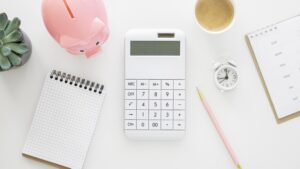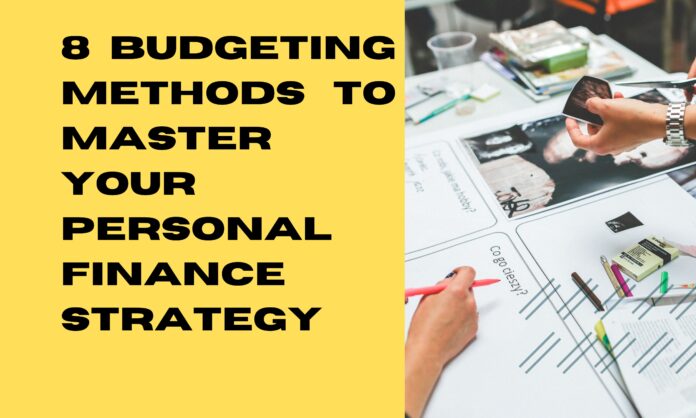Budgeting is one of the most important skills for managing your personal finance strategy. It helps you plan how to spend your money, save for your goals, and avoid debt. However, budgeting can also be challenging and confusing. There are different budgeting methods to choose from, each with pros and cons.
In this blog post, we will explore 8 budgeting methods you can use to master your personal finance strategy. We will explain what each method is, how it works, and who it is best suited for.
By the end of this post, you will better understand which budgeting method is right for you and how to implement it.
Table of Contents
- Reverse Budget
- Envelope System
- 50/30/20 Budget
- Traditional Budget
- Zero-Based Budget
- Pay Yourself First Budget
- Conscious Spending Plan
- Fixed Versus Variable Expenses Budget
- Final Words
8 Budgeting Methods for Personal Finance Strategy
Reverse Budget
The reverse budget is a simple and effective personal finance budgeting method. It allocates your paycheck to your savings goals first and then uses the remaining money for your expenses. This way, you ensure that you are saving enough for your future, and you don’t have to worry about tracking and monitoring every single expense.
The reverse budget works well for people with a predictable income and specific savings goals. It includes retirement, emergency funds, or a big purchase. Also, it works well for people who don’t like to micromanage their spending and who prefer to have some flexibility and freedom with their money.
To use the reverse budget, you need to follow these steps:
- Calculate your monthly income after taxes and deductions.
- Decide how much you want to save each month for your goals, and set up automatic transfers to your savings accounts.
Use the remaining money for your expenses, such as rent, utilities, groceries, etc. You can divide this money into categories or just spend it as you go, as long as you don’t overspend.
Envelope System
The envelope system is a classic and popular budgeting hack as a personal finance strategy. It enables you to allocate cash to different envelopes for your spending categories, such as rent, utilities, groceries, etc.
Once an envelope is empty, you can’t spend any more money on that category unless you take money from another envelope. But once all the envelopes are empty, that’s until your next paycheck.
The envelope system works well for people who have difficulty controlling their spending and need a visual and physical reminder of how much money they have left. It also works well for people who prefer cash over cards and don’t have many online or automatic payments.
To use the envelope system, you need to follow these steps:
- Calculate your monthly income after taxes and deductions.
- Decide how much you want to spend on each category, and label an envelope for each one.
- Withdraw cash from your bank account and distribute it among the envelopes according to your budget.
- Use the cash from the envelopes for your spending, and keep the receipts in the envelopes for tracking.
If you have any money left over at the end of the month, you can save it, roll it over to the next month, or treat yourself.
50/30/20 Budget – Best Personal Finance Strategy
The 50/30/20 budget is a simple and flexible budgeting method that divides your take-home pay into three categories:
- 50% for your needs,
- 30% for your wants, and
- 20% for your savings and debt payments.
This personal finance strategy gives you a general guideline for how much to allocate to each category without having to worry about the details.
The 50/30/20 budget works well for people who want a balanced and realistic approach to budgeting and who don’t want to spend too much time or effort on it. It also works well for people who have a variable income and need to adjust their budget every month.
To use the 50/30/20 budget, you need to follow these steps:
- Calculate your monthly income after taxes and deductions.
- Multiply your income by 0.5, 0.3, and 0.2 to get the amounts for your needs, wants, and savings/debt categories.
- Identify your needs, such as housing, food, transportation, insurance, etc., and make sure they don’t exceed 50% of your income.
- Identify your wants, such as entertainment, hobbies, travel, etc., and make sure they don’t exceed 30% of your income.
- Identify your savings and debt goals, such as retirement, emergency fund, credit card payments, etc., and make sure they don’t exceed 20% of your income.
Traditional Budget

The traditional budget is a detailed and comprehensive budgeting method that allocates your salary to a list of expense categories based on historical data or an estimate. The goal is to limit your spending to the assigned amount for each category, so you need to track and monitor your expenses regularly.
The traditional budget works well for people who want to have more control and accuracy over their spending and who like to plan ahead and analyze their finances. It also works well for people with fixed and consistent expenses.
To use the traditional budget, you need to follow these steps:
- Calculate your monthly income after taxes and deductions.
- Review your past spending habits and create a list of expense categories, such as rent, utilities, groceries, etc.
- Assign a realistic and reasonable amount for each category based on your income and goals.
- Track your expenses throughout the month using an app, a spreadsheet, or a notebook.
This personal finance strategy asks you to compare your actual spending to your budget and adjust accordingly.
Zero-Based Budget – Conservative Personal Finance Strategy
The zero-based budget is a strict and disciplined budgeting method. It assigns every dollar of your income to a specific purpose, with the goal of allocating all your income to your expenses, savings goals, and debt payments. When you’re done, your income minus your expenses should equal zero because every dollar is accounted for.
The zero-based budget works well for people who want to maximize their money and who are willing to spend time and effort on their budget. It also works well for people who have a clear vision of their financial goals and who are motivated to achieve them.
To use the zero-based budget, you need to follow these steps:
- Calculate your monthly income after taxes and deductions.
- List all your expenses, savings goals, and debt payments, and prioritize them according to their importance and urgency.
- Assign a specific amount for each item on your list, starting from the top and working your way down until you reach zero.
- Track your monthly income and expenses and ensure they match your budget.
Adjust your budget accordingly if you have any leftover income or any unexpected expenses.
Pay Yourself First Budget
The pay-yourself-first budget is a personal finance strategy that allocates a portion of your income to your savings or investments first before you cover your fixed and variable expenses. This way, you ensure that you are building your wealth and securing your future, and you don’t have to worry about saving what’s left at the end of the month.
The pay-yourself-first budget works well for people with a high income and enough money to cover their expenses and save a significant amount. It also works well for people who have long-term and ambitious savings goals, such as retirement, education, or a house.
To use the pay-yourself-first personal finance budget, you need to follow these steps:
- Calculate your monthly income after taxes and deductions.
- Decide how much you want to save or invest each month, and set up automatic transfers to your savings or investment accounts.
- Divide your remaining income into fixed and variable expenses and allocate a specific amount for each category.
Use the money from your fixed and variable expenses categories for your spending, and track your expenses to make sure you don’t overspend.
Conscious Spending Plan
The conscious spending plan is a budgeting method that allocates fixed percentages of your income to four categories: fixed expenses, guilt-free spending, savings, and investments. This gives you a simple and easy way to manage your money without having to sacrifice your happiness or your future.
The conscious spending plan works well for people who want to enjoy their money and who don’t want to feel guilty or restricted by their budget. It also works well for people who have a moderate income and who can afford to save and invest a decent amount.
To use the conscious spending plan, you need to follow these steps:
- Calculate your monthly income after taxes and deductions.
- Multiply your income by 0.6, 0.1, 0.2, and 0.1 to get the amounts for your fixed expenses, guilt-free spending, savings, and investments categories.
- Identify your fixed expenses, such as rent, utilities, insurance, etc., and make sure they don’t exceed 60% of your income.
- Identify your guilt-free spend, such as entertainment, hobbies, travel, etc., and make sure they don’t exceed 10% of your income.
- Identify your savings and investment goals, such as retirement, emergency fund, education, etc., and make sure they don’t exceed 30% of your income.
Fixed Versus Variable Expenses Budget
The fixed versus variable expenses budget is a budgeting method that divides your paycheck between your fixed and variable expenses. Fixed expenses are regular costs that are typically the same each month, such as rent, mortgage, car payment, insurance, etc.
Variable expenses are costs that vary each month based on your usage, such as groceries, eating out, entertainment, gas, etc.
The fixed versus variable expenses budget works well for people who want to have a simple and easy way to budget and who don’t have many savings or debt goals. It also works well for people with a low or irregular income and who need to adjust their monthly spending.
To use the fixed versus variable expenses budget, you need to follow these steps:
- Calculate your monthly income after taxes and deductions.
- Identify your fixed expenses and add them up to get the total amount.
- Subtract your fixed expenses from your income and use the remaining amount for your variable expenses.
- Track your variable expenses throughout the month, and make sure you don’t spend more than you have.
Final Words
As you can see, there are many different budgeting methods that you can use to master your personal finance strategy. Each has advantages and disadvantages, and each suits different people and situations. The best budgeting method for you is the one that helps you achieve your goals, fits your lifestyle, and makes you happy.
We hope this blog post has helped you understand the 8 budgeting methods that we have discussed and how to use them.
If you have any questions or comments, please feel free to leave them below. We would love to hear from you.





Hi, I think your website might be having browser compatibility issues.
When I look at your blog site in Safari, it looks fine but when opening in Internet Explorer, it has some
overlapping. I just wanted to give you a quick heads up!
Other then that, awesome blog!
Hello my loved one! I want to say that this post is awesome, nice
written and include almost all significant infos. I would like to look extra posts like this .